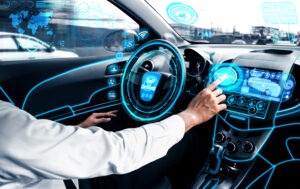As the automotive industry competes to release the most advanced, connected car they can, Damien Stephens takes a look at the challenges and opportunities there are for retrofitting older models.
What kind of car do you drive? A Prius, Focus or maybe a Golf? Perhaps you’re on first-name terms and prefer to refer to your ride as Pete, Freddy or Gerry? Regardless of whether you find rechristening your wheels quirky or cringeworthy, a 2018 survey by the UK’s Driver and Vehicle Licensing Agency found that nearly 30% of drivers have given their car a nickname. While Brits might be more likely to name their cars than drivers in the US or India, it does show that some people treat their cars almost like big, mechanical pets.
 It’s of course not just because of emotional attachments that people are often keen to keep hold of their vehicles for as long as possible. After all, buying a new car is expensive. And, even when it’s time to swap Freddy for a newer model, most drivers in the US, for example, opt for a used car instead of a new one. In 2018, out of the almost 60 million cars sold in the country, around 40 million were used – or pre-loved – vehicles, despite newer models with more advanced technology coming to market. So, the average age of vehicles on American roads has gone up by around 4% in the last five years, reaching the tender age of almost 12 in 2019.
It’s of course not just because of emotional attachments that people are often keen to keep hold of their vehicles for as long as possible. After all, buying a new car is expensive. And, even when it’s time to swap Freddy for a newer model, most drivers in the US, for example, opt for a used car instead of a new one. In 2018, out of the almost 60 million cars sold in the country, around 40 million were used – or pre-loved – vehicles, despite newer models with more advanced technology coming to market. So, the average age of vehicles on American roads has gone up by around 4% in the last five years, reaching the tender age of almost 12 in 2019.
This might sound surprising, especially as automakers worldwide are racing to bring to market the latest and greatest connected cars and investing in R&D to enable autonomous driving in the future.
“Ovum predicts that there will be 1.5 billion cars on the world’s roads by 2022, with 300 million of them boasting different connected features.”
That might sound like a lot, but it’s only 20% of the planet’s total fleet, meaning more cars may well have nicknames than IoT capabilities.
For maximising the wider impact of IoT, a lack of connected cars could become a problem. Many of the wider  benefits of IoT, such as traffic management systems, road safety initiatives and smart city infrastructures, rely on as many points creating data as possible in order for systems to build up a comprehensive picture of what’s happening within the world. The better the insights, the more effectively things can be managed – but the more vehicles that aren’t on the grid the less efficient the whole system can be.
benefits of IoT, such as traffic management systems, road safety initiatives and smart city infrastructures, rely on as many points creating data as possible in order for systems to build up a comprehensive picture of what’s happening within the world. The better the insights, the more effectively things can be managed – but the more vehicles that aren’t on the grid the less efficient the whole system can be.
This disparity might seem like a significant hurdle for transport-based IoT to overcome, but it also could also create a great new opportunity for a burgeoning ‘aftermarket’ IoT industry.
“If connectivity and sensors could be retrofitted to a higher number of older cars, the much-talked-about vision of a truly smart cities and connected car ecosystems could become a reality for more people around the world.”
Given the high proportion of older vehicles on the roads, it will be a challenge to equip them with IT connectivity. Vehicle manufacturers and more importantly local dealers, could both be well-placed to install the necessary SIM cards and sensors in cars that were originally built without them, ensuring that everything works holistically. However, this could also pave the way for new dedicated connectivity equipment installers. Such specialist businesses could also offer other value-added services and expertise, including apps for diagnostics or geo-located breakdown and repair assistance.
Once a previously unconnected vehicle has been given a new lease of life with IoT, drivers and passengers could soon be looking for ways to take advantage of their car’s new data-enabled capabilities. The average connected car generates around 4TB of data each day, and it’s not just used to help the traffic flow in your local city centre.
“Onboard sensors can capture data to monitor road and driving conditions to inform other road users of areas to avoid and alert local authorities to highways that are most in need of attention.”
They can also collect data on car usage and driver behaviour, which in turn helps with usage based insurance  policies and helps fleet managers make business decisions remotely based on driver performance. All the data collected could steer automakers’ future vehicle designs too, thanks to the wealth of data on drivers’ preferences at their fingertips.
policies and helps fleet managers make business decisions remotely based on driver performance. All the data collected could steer automakers’ future vehicle designs too, thanks to the wealth of data on drivers’ preferences at their fingertips.
One issue with retrofitting older cars with SIMs and IoT-enabled sensors does remain, however. Unlike cutting-edge eSIMs – which are built into vehicles at the factory – traditional SIMs are always associated with a specific mobile network operator. And that network might be super-fast in some places and have not-spots in others, leading to a poor driving experience in the newly connected car. The latest eSIMs however, give the car manufacturers the flexibility to choose the best mobile network and swap connectivity depending on the different data needs of various connected car applications.
Ultimately, regardless of how a car gets connected, the crucial thing is that more drivers are able to tap into the opportunities that IoT offers: seamless access to infotainment, predictive maintenance and navigation insights, not to mention the many way in which cars could communicate with the world around it. It will all make our roads safer and people’s lives easier too. Given this transformational potential – not to mention the new revenues that it could generate – automakers should consider how to connect both new vehicles and their older cousins already on the roads – including the ones with nicknames.
Read more about the technologies revolutionising the automotive industry here.
Transformational Hybrid SolutionsOur cloud-enablement services offer the best performance on your traffic-heavy websites or mission-critical applications.
Core NetworksTata Communications™ global IT infrastructure and fibre network delivers the resources you need, when and where you need them.
Network Resources
Unified Communications As A ServiceBreak the barriers of borders efficiently and increase productivity with Tata Communications’ UC&C solutions.
Global SIP ConnectEmpower your business with our SIP network and witness it grow exponentially.
InstaCC™ - Contact Centre As A ServiceCloud contact centre solutions for digital customers experience and agent productivity.
Unified Communication Resources Case studies, industry papers and other interesting content to help you explore our unified communications solution better.
IoT SolutionsThe Internet of Things is transforming the way we experience the world around us for good. Find out more about our Internet Of Things related solutions here.
Mobility SolutionsTata Communications’ mobility services enable your enterprise to maintain seamless communication across borders, with complete visibility of cost and usage.
Mobility & IoT Resources
Multi-Cloud SolutionsWith enterprises transitioning to a hybrid multi-cloud infrastructure, getting the right deployment model that yields ROI can be a daunting task.
Cloud ComplianceCompliant with data privacy standards across different countries and is also designed to protect customers’ privacy at all levels.
IZO™ Cloud Platform & ServicesIZO™ is a flexible, one-stop cloud enablement platform designed to help you navigate complexity for more agile business performance.
Managed Infrastructure ServicesIntegrated with our integrated Tier-1 network to help your business grow efficiently across borders.
Cloud PartnersWe support a global ecosystem for seamless, secure connectivity to multiple solutions through a single provider.
Cloud Resources
Governance, Risk, and ComplianceRisk and Threat management services to reduce security thefts across your business and improve overall efficiencies and costs.
Cloud SecurityBest-in-class security by our global secure web gateway helps provide visibility and control of users inside and outside the office.
Threat Management - SOCIndustry-leading threat-management service to minimise risk, with an efficient global solution against emerging security breaches and attacks.
Advanced Network SecurityManaged security services for a predictive and proactive range of solutions, driving visibility and context to prevent attacks.
Cyber Security ResourcesCase studies, industry papers and other interesting content to help you explore our securtiy solution better.
Hosted & Managed ServicesTata Communications provide new models for efficient wholesale carrier voice service management. With our managed hosting services make your voice business more efficient and better protected
Wholesale Voice Transport & Termination ServicesYour long-distance international voice traffic is in good hands. End-to-end, voice access & carrier services which includes voice transport and termination with a trusted, global partner.
Voice Access ServicesTata Communication’s provide solutions which take care of your carrier & voice services, from conferencing to call centre or business support applications.
Carrier Services Resources
CDN Acceleration ServicesOur CDN Web Site Acceleration (WSA) solution helps deliver static and dynamic content, guaranteeing higher performance for your website.
CDN SecuritySafeguard your website data and customers’ information by securing your website from hacks and other mala fide cyber activities.
Video CDNDeliver high-quality video content to your customers across platforms – website, app and OTT delivery.
CDN Resources
Elevate CXIncrease customer satisfaction while empowering your service team to deliver world-class customer experience and engagement.
Live Event ServicesTata Communications’ live event services help battle the share if eyeballs as on-demand video drives an explosion of diverse content available on tap for a global audience.
Media Cloud Infrastructure ServicesTata Communications’ media cloud infrastructure offers flexible storage & compute services to build custom media applications.
Global Media NetworkTata Communications’ global media network combines our expertise as a global tier-1 connectivity provider with our end-to-end media ecosystem.
Use CasesUse cases of Tata Communications’ Media Entertainment Services
Remote Production SolutionsMedia contribution, preparation and distribution are highly capital-intensive for producers of live TV and video content, and their workflows are complex.
Media Cloud Ecosystem SolutionsThe Tata Communications media cloud infrastructure services offer the basic building blocks for a cloud infrastructure-as-a-service.
Global Contribution & Distribution SolutionsTata Communications’ global contribution and distribution solution is built to reduce capital outlay and grow global footprint.
Satellite Alternative SolutionsAs more and more consumers choose to cut the cord & switch to internet-based entertainment options, broadcasters are faced with capital allocation decisions.
LeadershipA look into the pillars of Tata communications who carry the torch and are living embodiment of Tata’s values and ethos.
Culture & DiversityHere at Tata Communications we are committed to creating a culture of openness, curiosity and learning. We also believe in driving an extra mile to recognize new talent and cultivate skills.
OfficesA list of Tata Communications office locations worldwide.
FAQCheck out our FAQs section for more information.
SustainabilityOur holistic sustainability strategy is grounded in the pillars of People, Planet and Community with corporate governance at the heart of it.
BoardHave a look at our board of members.
ResultsFind out more about our quarterly results.
Investor PresentationsFollow our repository of investor presentations.
FilingsGet all information regarding filings of Tata communications in one place.
Investor EventsAll investor related event schedule and information at one place.
GovernanceAt Tata, we believe in following our corporate social responsibility which is why we have set up a team for corporate governance.
SharesGet a better understanding of our shares, dividends etc.
SupportGet all investor related contact information here.


